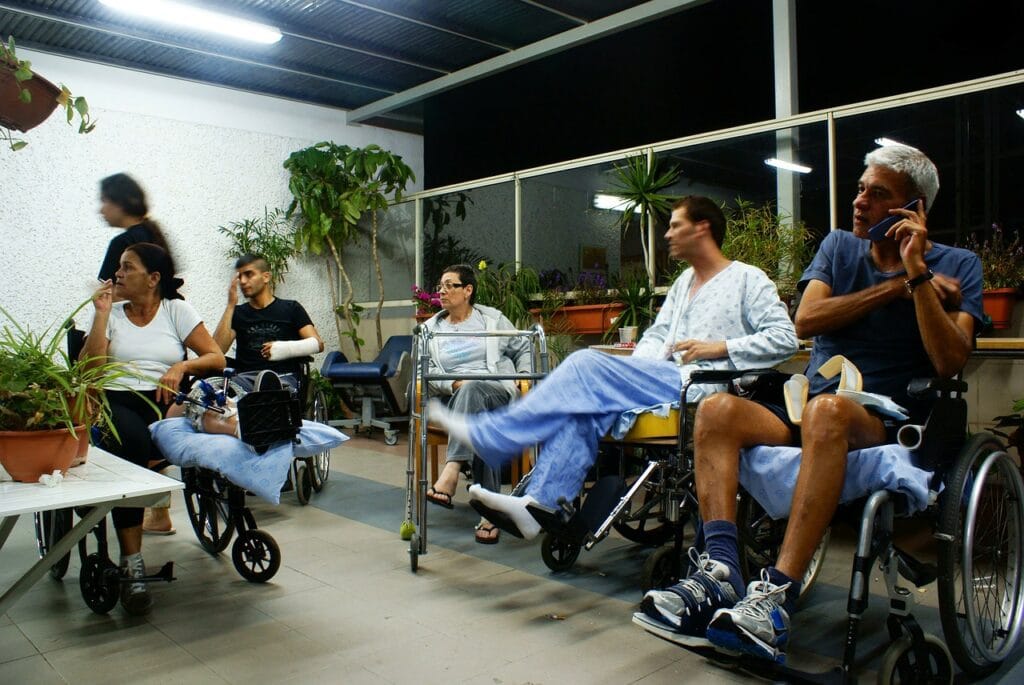
Private doctor or hospital liens can become a huge problem in your case, without a reduction of these liens you could end up netting significantly less than what the gross settlement or judgment was. They are also notoriously difficult to negotiate because the hospital will be represented by an attorney who is likely being paid a percentage of the lien that he is able to recover. Nonetheless, I have broken down five (5) concrete steps with supporting statutes and case law that have worked for me in the past when negotiating these types of liens:
STEP 1 — Reduce Hospital Bill For Unreasonable/Unnecessary Charges
The Hospital Lien Act (“HLA”), set forth in Cal. Civ. Code Sections 3045.1-3045.6, limits a hospital’s lien to “the amount of the reasonable and necessary charges of the hospital” for the services it rendered to the injured patient. It is the hospital’s burden to prove that its lien for the full hospital bill represents reasonable and necessary charges for the medical services provided. For example, in State Farm Mutual Automobile Ins. Co. v. Huff, 216 Cal.App.4th 1463 (2013), the appellate court held the hospital who provided collision related medical services to the appellant, “was not entitled to any damages because it did not prove the charges for its services were ‘reasonable and necessary.’” State Farm, 216 Cal.App.4th at 1466 (citing Cal. Civ. Code § 3045.1).
In California, “the full amount billed by medical providers is not an accurate measure of the value of medical services.” Corenbaum v. Lampkin, 215 Cal.App.4th 1308, 1326 (2013). This is because “many patients…pay discounted rates,” and standard rates “for a given service can vary tremendously, sometimes by a factor of five or more, from hospital to hospital in California.” Howell v. Hamilton Meat & Provisions, Inc., 52 Cal.4th 541, 561 (2011). For the same reasons plaintiffs are not allowed to use evidence of the full billed amount to prove past medical damages, a hospital similarly cannot use the full billed amount as evidence of the value of its services. Therefore, require the hospital to reduce its bill by looking at comparable cash rates and discounted insurance rates.
STEP 2 — Reduce Total Recovery By Priority Liens
Pursuant to the California Welfare and Institutions Code, where there is an award of money in a lawsuit against a third party or carrier, “the court or agency shall first order paid from any judgment or award the reasonable litigation expenses incurred in preparation and prosecution of the action or claim, together with reasonable attorney’s fees, when an attorney has been retained. After payment of these expenses and attorney’s fees the court or agency shall, on application of the director, allow as a first lien against the amount of the settlement, judgment, or award the reasonable value of additional benefits provided to the beneficiary under the Medi-Cal program, as provided in subdivision (d) of Section 14124.72, and as a second lien, the amount of any claims, pursuant to Section 14019.3, owed to a provider, as provided in Section 14124.791.” Welf. & Inst. Code § 14124.74(a) (emphasis added); see also County of San Bernardino v. Calderon, 148 Cal.App.4th 1103 (2007) (affirming trial court holding that attorney fees were created before hospital’s lien and that therefore the attorney’s lien has priority over the hospital lien).
Liens asserted under the HLA are essentially given last priority, after any attorney and/or Medi-Cal liens. Therefore, start by reducing the total recovery by your attorney’s fees and litigation costs. Prior attorney liens must also be paid in order, starting with the first attorney assigned on the matter. Next, reduce that amount by the reasonable value of services provided by Medi-Cal, if any. If there are other competing doctor liens or private hospital liens, these must also be paid in order, starting with the first lien asserted.
NOTE: There are certain notice and substance requirements for a private hospital lien to be effective, including written notice containing the name and address of the injured person, date of the accident, name and location of the hospital, amount claimed as reasonable and necessary charges, etc. See Cal. Civ. Code § 3045.3. Thus, make sure the hospital lien satisfies these notice requirements. Further, “a provider may only recover upon the lien if the provider has made a full reimbursement of any fees paid by [Medi-Cal] for those services.” Welf. & Inst. Code § 14124.791(a).
STEP 3 — Apportion For Multiple Claimants
Having subtracted applicable attorney fees, litigation costs, prior attorney liens, Medi-Cal liens, and priority hospital/doctor liens, you will now have a net number which represents your client(s) net recovery. Where there are multiple claimants or plaintiffs, this net recovery must further be apportioned to each plaintiff. Multiply the total net recovery by the percentage apportioned to the particular plaintiff that the private hospital lien is attached to. The lien is only attached to any recovery attributable to the injured patient that received medical care by the hospital who is now asserting the lien.
STEP 4 — Make Statutory Reductions to Lien Amount
Because a settlement or judgment against a third-party required the skill, time and labor of the attorney, any provider of medical services to the injured party who now seeks reimbursement for its services (i.e., a lien), must reduce its lien to account for attorney fees and litigation costs. “The provider’s claim for reimbursement for fees for services rendered to the beneficiary shall be limited to the amount of the fees less 25 percent, which represents the provider’s reasonable share of attorneys’ fees for prosecution of the action and of the cost of litigation expense.” Welf. & Inst. Code § 14124.791(c). Therefore, reduce the hospital’s lien by twenty-five percent (25%) right off the top.
Pursuant to the statutory scheme for reducing such hospital liens, under Cal. Civ. Code Section 3045.4, such private hospital liens are only entitled to a maximum of fifty percent (50%) of the net due to the plaintiff or injured patient. Therefore, multiply the net recovery due to the plaintiff by fifty percent (50%). This number does not represent a negotiated reduction by the hospital, it also does not include any reduction for non-economic damages or other ethical considerations. Rather, this number is the maximum potential money available for the private hospital lien to attach to. Therefore, any amount of the private hospital lien that exceeds fifty percent (50%) of the plaintiff’s net recovery is essentially truncated.
In summary, at this point in the analysis you should have the following numbers:
Plaintiff’s Net Recovery = (Gross Recovery − Attorney Fees − Litigation Costs − Prior Attorney Liens − Medi-Cal Liens − Priority Hospital/Doctor Liens) x Percentage Apportioned
Statutorily Reduced Private Hospital Lien = Private Hospital Lien x 75%
Maximum Available Amount = Plaintiff’s Net Recovery x 50%
If the “Statutorily Reduced Private Hospital Lien” number is greater than the “Maximum Available Amount” number, use the latter number as the baseline for negotiations. This is because the hospital lien cannot exceed fifty percent (50%) of the net due to the plaintiff. Cal. Civ. Code § 3045.4.
If the “Statutorily Reduced Private Hospital Lien” number is less than the “Maximum Available Amount” number, use the former as the baseline for negotiations. The hospital’s lien is multiplied by seventy-five percent (75%), i.e., a twenty-five percent (25%) discount attributable to it’s share of attorney’s fees and case costs. Welf. & Inst. Code § 14124.791(c).
Example 1:
Assume that a Plaintiff’s Net Recovery is $500,000 from a settlement
Also assume there is a private hospital lien for $800,000
Statutorily Reduced Private Hospital Lien = $800,000 x 75% = $600,000
Maximum Available Amount = $500,000 x 50% = $250,000
In this example, even after reducing the private hospital lien to account for attorney’s fees and case costs, the reduced lien ($600,000) still well exceeds fifty percent (50%) of the net to the plaintiff ($250,000). Therefore, the maximum amount of money the hospital lien is attached to is $250,000. This is still without consideration as to apportionment of special damages, non-economic damages and other ethical considerations.
Example 2:
Assume that a Plaintiff’s Net Recovery is $500,000 from a settlement
Also assume there is a private hospital lien for $300,000
Statutorily Reduced Private Hospital Lien = $300,000 x 75% = $225,000
Maximum Available Amount = $500,000 x 50% = $250,000
In this example, the reduced hospital lien is less than fifty percent (50%) of the net due to the plaintiff. Therefore, the reduced hospital lien of $225,000 should be the starting point for negotiations.
STEP 5 — Specify the Portion of Recovery Attributable to Past Medical Expenses
Regardless of whether recovery was obtained by settlement or judgment, the amount represents monetary compensation for all of the injured plaintiff’s damages, not just for past medical expenses. Indeed, the majority of damages in personal injury matters are often attributable to non-economic type damages like pain and suffering, not past medical expenses. Future medical expenses, lost wages, lost earning capacity, property damage, etc. are also potential economic damages that were awarded. Therefore, subtract any award for damages unrelated to past medical expenses from the baseline number calculated above.
Unlike a judgment where the different damage awards are separately determined and clearly enumerated, settlement awards lump everything together. Therefore, it is imperative to specify the portion of recovery attributable to past medical expenses, since that is the only portion of recovery that the hospital lien is attached to. For example, in the settlement context where the separate damage awards are not enumerated, a discussion as to the plaintiff’s injuries, recovery status and future medical requirements will be necessary to separate out future medical expenses from the settlement award. In addition, a discussion as to non-economic damages, the effect of the accident on the injured person’s life, pain and suffering experienced by the injured person, etc. will be necessary to separate out general damages from the settlement.
Ultimately, reduction of a private hospital lien is a negotiation. This means there are other ethical and logistical considerations that may also be part of the equation. For example, imagine the situation where a hard-fought settlement has finally been agreed by all parties, however, the only thing holding up the settlement is a reasonable reduction in a private hospital lien. This scenario happens all the time. The hospital’s willingness to help the settlement by reducing its lien becomes the pivotal factor for the entire case being resolved and both the hospital and plaintiff receiving some portion of money. This may sway an otherwise unwilling lien holder. Requiring court intervention in these scenarios is also a potential avenue to reduce the lien. Regardless of the individual issues of each case, reducing the lien starts with the above five (5) steps.
DISCLAIMER: The content above is entirely the opinion of Pan Law Group, Inc. and should in no way be considered legal advice. Please contact us for a free legal consultation if you have any questions. Thank you.






